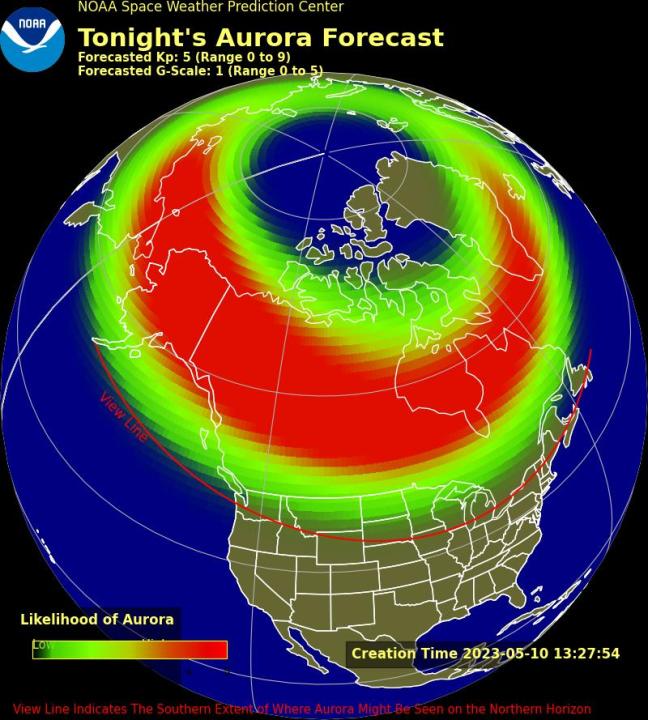Another solar storm may bring northern lights to US Wednesday, Thursday
(NEXSTAR) – Amid high solar activity, many states have already had multiple chances to see the northern lights over the last two months. Another round of activity on the sun has caused a geomagnetic storm watch, bringing another chance for parts of the U.S. to see the auroras.
On Sunday, a partial halo coronal mass ejection, or CME, “erupted from the Sun,” according to the National Weather Service’s Space Weather Prediction Center (SPWC). The CME is expected to impact Earth Wednesday, prompting a geomagnetic storm watch that stretches into Thursday.
CMEs are explosions of plasma and magnetic material from the sun that can reach Earth in as little as 15 to 18 hours, NOAA explains. Solar flares and CMEs (which can occur at the same time) can impact navigation, communication and radio signals on Earth, and CMEs are able to create a stunning show in the night sky. According to NASA, CMEs can create currents in Earth’s magnetic fields that send particles to the North and South Poles. When those particles interact with oxygen and nitrogen, they can create auroras.
In late April, when a similar storm watch was activated, states as far south as Alabama were able to see the northern lights.
While it can be difficult to forecast where exactly the northern lights will be visible, a moderate geomagnetic storm – like the one that could impact Earth on Wednesday – can send auroras as far south as New York and Idaho, NOAA explains. Should the storm reach strong status, the northern lights could dip into Illinois and Oregon.
As of Tuesday night, the SWPC is forecasting a strong likelihood of the northern lights being visible across most of Alaska and Canada. Some states in the northern U.S. have a low likelihood of aurora viewing. That includes parts of Washington, Idaho, Montana, North Dakota, Minnesota and the very northern tip of Wisconsin and Michigan’s Upper Peninsula.
The auroras may, however, stretch even further south. Depicted with the red line on the map below, SWPC is forecasting the northern lights could also appear in parts of Wyoming, South Dakota, Iowa, Michigan, New York, Vermont, New Hampshire, and Maine.

What is causing the northern lights?
Much of the recent northern lights activity is thanks to activity on the sun.
We’re currently in Solar Cycle 25, which began in December 2019, according to Rob Steenburgh, a space scientist with the SWPC. During this cycle, an 11-year period, the sun will flip its magnetic poles and cause space weather, which are “variations in the space environment between the sun and Earth.”
That includes CMEs, which occur roughly twice a day when activity peaks during the solar cycle. While Steenburgh notes the majority of the eruptions don’t head toward Earth, those that do can spark stunning auroras.
Experts say we haven’t yet reached the most active point of the solar cycle, known as solar maximum. That likely won’t happen until next year, according to Steenburgh. The more activity on the sun, the better chances we have to see the northern lights.
While it can be difficult to tell when exactly the U.S. will have the chance to see the aurora borealis, NOAA does offer single-day and next-day forecasts for potential northern light viewing.
If you do have the chance to see the northern lights, it’s best to find a dark area away from city lights. If you’re hoping to increase the likelihood of catching the auroras, you’ll want to head north – Alaska and Canada frequently have the opportunity to catch the stunning colors light up the sky.









